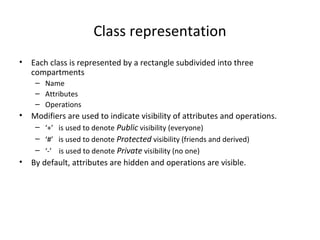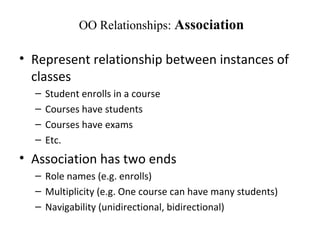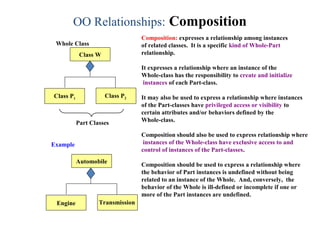UML Diagrams
- 1. Detailed Presentation on UML Akul Nigam(9911103424) Devesh Vashishtha(9911103451) Kartik Chaudhary(9911103477) Ritvik Bhardwaj(9911103529)
- 2. Overview • What is UML? • Understanding the basics of UML • Why UML? • UML diagrams • UML Modeling tools
- 3. What is UML? • UML stands for “Unified Modeling Language” • Modeling is describing system at a high level of abstraction • It is a industry-standard graphical language for specifying, visualizing, constructing, and documenting the artifacts of software systems • The UML uses mostly graphical notations to express the OO analysis and design of software projects. • Simplifies the complex process of software design
- 4. Why UML for Modeling/Benefits of UML • Use graphical notation to communicate more clearly than natural language (imprecise) and code(too detailed). • Quick understanding • Help acquire an overall view of a system. • Lessens chances of conflicts. • UML is not dependent on any one language or technology. • Necessary to manage complexity. • UML moves us from fragmentation to standardization.
- 5. Types of UML Diagrams • Use Case Diagram • Class Diagram • Activity Diagram • Sequence Diagram • Collaboration Diagram • State Diagram • Deployment Diagram
- 6. Use Case Diagram • Used for describing a set of user scenarios • Illustrates functionality provided by the system • Mainly used for capturing user requirements • Work like a contract between end user and software developers
- 7. Use Case Diagram (core components) Actors: A role that a user plays with respect to the system,including human users and other systems. e.g.,inanimate physical objects (e.g. robot); an external system that needs some information from the current system. Use case: A set of scenarios that describing an interaction between a user and a system, including alternatives. System boundary: rectangle diagram representing the boundary between the actors and the system.
- 8. Use Case Diagram(core relationship) Association: communication between an actor and a use case; Represented by a solid line. Generalization: relationship between one general use case and a special use case (used for defining special alternatives) Represented by a line with a triangular arrow head toward the parent use case.
- 9. Use Case Diagram(core relationship) Extend: a dotted line labeled <<extend>> with an arrow toward the base case. The extending use case may add behavior to the base use case. The base class declares “extension points”. <<extend>> Include: a dotted line labeled <<include>> beginning at base use case and ending with an arrows pointing to the include use case. The include relationship occurs when a chunk of behavior is similar across more than one use case. Use “include” in stead of copying the description of that behavior. <<include>>
- 10. Use Case Diagrams Library System Borrow Order Title Fine Remittance Client Employee Supervisor • A generalized description of how a system will be used. • Provides an overview of the intended functionality of the system Boundary Actor Use Case
- 12. Use Case Diagrams(cont.) •Pay Bill is a parent use case and Bill Insurance is the child use case. (generalization) •Both Make Appointment and Request Medication include Check Patient Record as a subtask.(include) •The extension point is written inside the base case Pay bill; the extending class Defer payment adds the behavior of this extension point. (extend)
- 13. Class diagram • Used for describing structure and behavior in the use cases • Provide a conceptual model of the system in terms of entities and their relationships • Used for requirement capture, end-user interaction • Detailed class diagrams are used for developers
- 14. Class representation • Each class is represented by a rectangle subdivided into three compartments – Name – Attributes – Operations • Modifiers are used to indicate visibility of attributes and operations. – ‘+’ is used to denote Public visibility (everyone) – ‘#’ is used to denote Protected visibility (friends and derived) – ‘-’ is used to denote Private visibility (no one) • By default, attributes are hidden and operations are visible.
- 15. An example of Class Account_Name - Customer_Name - Balance +addFunds( ) +withDraw( ) +transfer( ) Name Attributes Operations
- 16. OO Relationships • There are two kinds of Relationships – Generalization (parent-child relationship) – Association (student enrolls in course) • Associations can be further classified as – Aggregation – Composition
- 17. Subtype2 Supertype Subtype1 OO Relationships: Generalization - Generalization expresses a parent/child relationship among related classes. - Used for abstracting details in several layers Regular Customer Loyalty Customer CustomerExample: Regular Customer Loyalty Customer Customeror:
- 18. OO Relationships: Association • Represent relationship between instances of classes – Student enrolls in a course – Courses have students – Courses have exams – Etc. • Association has two ends – Role names (e.g. enrolls) – Multiplicity (e.g. One course can have many students) – Navigability (unidirectional, bidirectional)
- 19. Association: Multiplicity and Roles University Person 1 0..1 * * Multiplicity Symbol Meaning 1 One and only one 0..1 Zero or one M..N From M to N (natural language) * From zero to any positive integer 0..* From zero to any positive integer 1..* From one to any positive integer teacheremployer Role Role “A given university groups many people; some act as students, others as teachers. A given student belongs to a single university; a given teacher may or may not be working for the university at a particular time.” student
- 20. Association: Model to Implementation Class Student { Course enrolls[4]; } Class Course { Student have[]; } Student Course enrollshas * 4
- 21. OO Relationships: Composition Class W Class P1 Class P2 Composition: expresses a relationship among instances of related classes. It is a specific kind of Whole-Part relationship. It expresses a relationship where an instance of the Whole-class has the responsibility to create and initialize instances of each Part-class. It may also be used to express a relationship where instances of the Part-classes have privileged access or visibility to certain attributes and/or behaviors defined by the Whole-class. Composition should also be used to express relationship where instances of the Whole-class have exclusive access to and control of instances of the Part-classes. Composition should be used to express a relationship where the behavior of Part instances is undefined without being related to an instance of the Whole. And, conversely, the behavior of the Whole is ill-defined or incomplete if one or more of the Part instances are undefined. Whole Class Part Classes Automobile Engine Transmission Example
- 22. OO Relationships: Aggregation Class C Class E1 Class E2 AGGREGATION Aggregation: expresses a relationship among instances of related classes. It is a specific kind of Container- Containee relationship. It expresses a relationship where an instance of the Container-class has the responsibility to hold and maintain instances of each Containee-class that have been created outside the auspices of the Container-class. Aggregation should be used to express a more informal relationship than composition expresses. That is, it is an appropriate relationship where the Container and its Containees can be manipulated independently. Aggregation is appropriate when Container and Containees have no special access privileges to each other. Container Class Containee Classes Bag Apples Milk Example
- 23. Aggregation vs. Composition •CompositionComposition is really a strong form of aggregation •components have only one owner •components cannot exist independent of their owner •components live or die with their owner e.g. Each car has an engine that can not be shared with other cars. •Aggregations may form "part of" the aggregate, but may not be essential to it. They may also exist independent of the aggregate. e.g. Apples may exist independent of the bag.
- 24. Class Diagram Example Hotel Management System
- 25. Activity Diagram • Procedural flow of control between two or more class objects • Activities are grouped into swim lanes. • Activity is modeled by drawing a rectangle with rounded edges, enclosing the activity's name. • Connected to other activities through transition lines • Activities that terminate the modeled process are connected to a termination point
- 26. Activity diagram, with two swim lanes to indicate control of activity by two objects: the band manager, and the reporting tool
- 27. Sequence Diagram • Two dimensional • Vertical dimension shows sequence of messages in the time order that they occur. • Horizontal dimension shows the object instances to which the messages are sent. • Self-Call can also be there in which a message that an object sends to itself.
- 28. Sequence Diagram(make a phone call) Caller Phone Recipient Picks up Dial tone Dial Ring notification Ring Picks up Hello
- 29. Sequence Diagrams – Object Life Spans • Creation – Create message – Object life starts at that point • Activation – Symbolized by rectangular stripes – Place on the lifeline where object is activated. – Rectangle also denotes when object is deactivated. • Deletion – Placing an ‘X’ on lifeline – Object’s life ends at that point Activation bar A B Create X Deletion Return Lifeline
- 30. Sequence Diagram User Catalog Reservations 1: look up () 2: title data () 3: [not available] reserve title () 4 : title returned () 5: hold title () 5 : title available () 6 : borrow title () 6 : remove reservation () Issuing a book from library
- 31. Collaboration Diagram • Shows the relationship between objects and the order of messages passed between them. • The objects are listed as rectangles and arrows indicate the messages being passed • Convey the same information as sequence diagrams, but focus on object roles instead of the time sequence.
- 32. Collaboration diagrams of earlier made sequence diagram of issuing of book from library User Catalog Reservations start 1: look up 2: title data 3 : [not available] reserve title 4 : title returned 5 : hold title 6 : borrow title 6: remove reservation 5: title available
- 33. State Diagrams State Diagrams show the sequences of states an object goes through during its life cycle in response to stimuli, together with its responses and actions; an abstraction of all possible behaviors. Unpaid Start End Paid Invoice created paying Invoice destroying (Billing Example)
- 34. Deployment Diagram • System will be physically deployed in the hardware environment • System's production staff makes its considerable use • Purpose is to show where the different components of the system will physically run and how they will communicate with each other
- 35. Deployment for ATM Machine
- 36. UML Modeling Tools • Rational Rose (www.rational.com) by IBM • TogetherSoft Control Center, Borland ( http://www.borland.com/together/index.html) • ArgoUML (free software) (http://argouml.tigris.org/ ) OpenSource; written in javawritten in java • Others (http://www.objectsbydesign.com/tools/umltools_byCompany.html )
- 37. Thank You!




















![Association: Model to Implementation
Class Student {
Course enrolls[4];
}
Class Course {
Student have[];
}
Student Course
enrollshas
* 4](https://image.slidesharecdn.com/umlpresentation-140519151641-phpapp02/85/UML-Diagrams-20-320.jpg)









![Sequence Diagram
User Catalog Reservations
1: look up ()
2: title data ()
3: [not available] reserve title ()
4 : title returned ()
5: hold title ()
5 : title available ()
6 : borrow title ()
6 : remove reservation ()
Issuing a book from library](https://image.slidesharecdn.com/umlpresentation-140519151641-phpapp02/85/UML-Diagrams-30-320.jpg)

![Collaboration diagrams of earlier made sequence diagram of issuing of book
from library
User
Catalog
Reservations
start
1: look up
2: title data
3 : [not available] reserve title
4 : title returned
5 : hold title
6 : borrow title
6: remove reservation
5: title available](https://image.slidesharecdn.com/umlpresentation-140519151641-phpapp02/85/UML-Diagrams-32-320.jpg)




